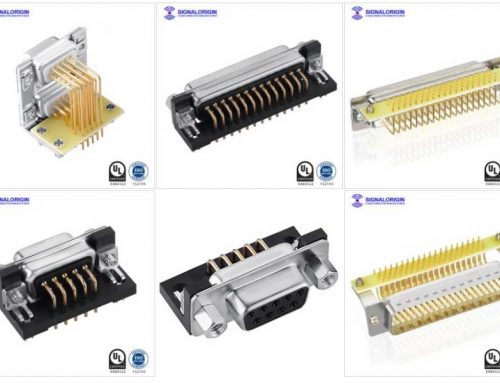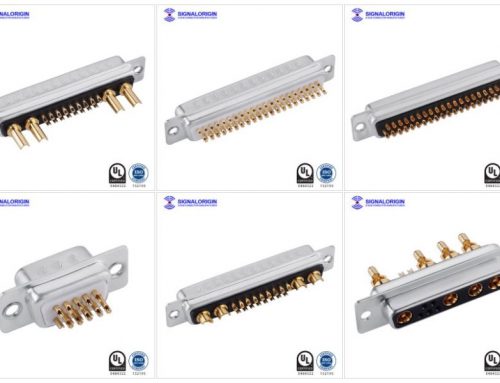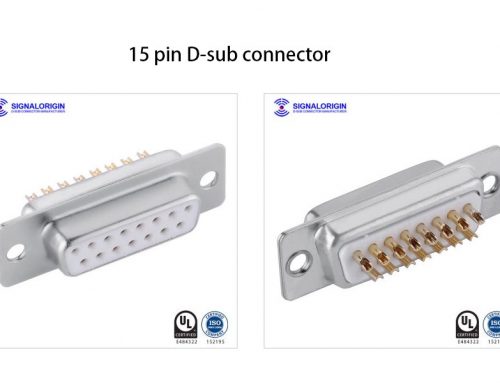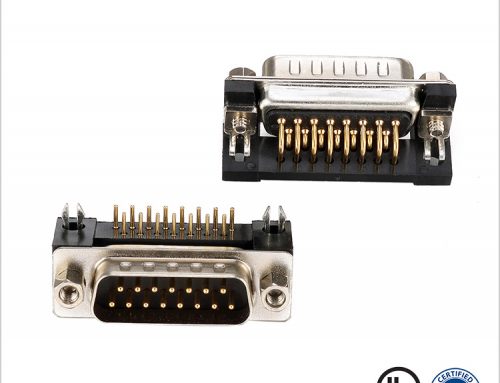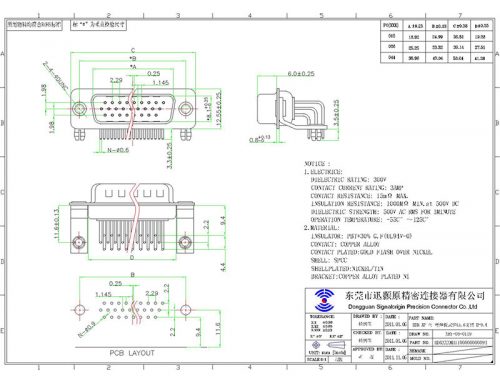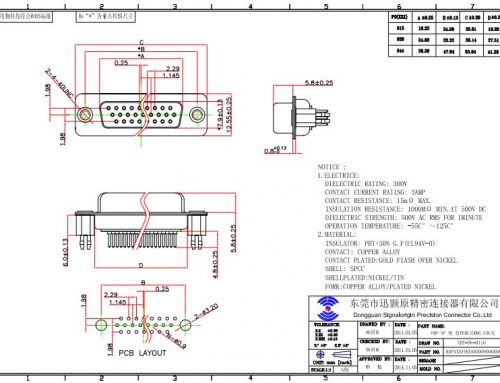The D-subminiature or D-sub is a common type of electrical connector. They are named for their characteristic D-shaped metal shield.
A D-sub contains two or more parallel rows of pins or sockets usually surrounded by a D-shaped metal shield that provides mechanical support, ensures correct orientation, and may screen against electromagnetic interference. The part containing pin contacts is called the male connector or plug, while that containing socket contacts is called the female connector or socket.
The socket’s shield fits tightly inside the plug’s shield. Panel mounted connectors usually have threaded nuts that accept screws on the cable end connector cover that are used for locking the connectors together and offering mechanical strain relief.
SIGNALORIGIN 9 pin d-sub connector
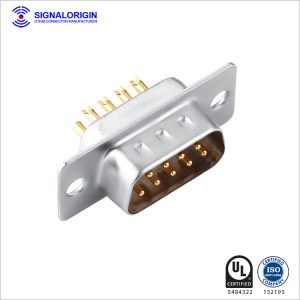 |
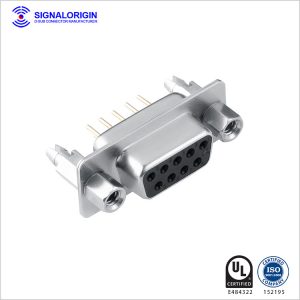 |
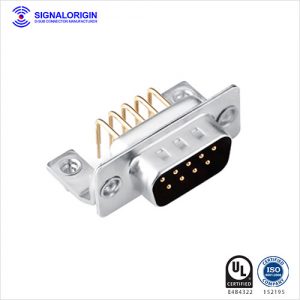 |
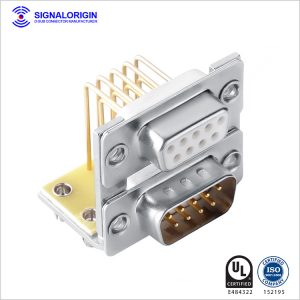 |
| Solder cup | Straight | Right angle | Dual port |
The D-sub series of connectors was introduced in 1952. We usually uses D as the prefix for the whole series, followed by one of A, B, C, D, or E denoting the shell size, followed by the number of pins or sockets, followed by either P (plug or pins) or S (socket) denoting the gender of the part. Each shell size usually (see below for exceptions) corresponds to a certain number of pins or sockets: A with 15, B with 25, C with 37, D with 50, and E with 9. For example, DB-25 denotes a D-sub with a 25-position shell size and a 25-position contact configuration. The contacts in each row of these connectors are spaced 326/3000 of an inch apart, or approximately 0.1087 inches (2.76 mm), and the rows are spaced 0.112 inches (2.84 mm) apart; the pins in the two rows are offset by half the distance between adjacent contacts in a row. This spacing is called normal density. The suffixes M and F (for male and female) are sometimes used instead of the original P and S for plug and socket.
The double density series of D-sub connectors features even denser arrangements and consists of the DE-19, DA-31, DB-52, DC-79, and DD-100. These each have three rows of pins, except the DD-100, which has four. Reflecting the same confusion of the letters DB with just D as mentioned above, high density connectors are also often called DB-15HD (or even DB-15 or HD-15), DB-26HD (HD-26), DB-44HD, DB-62HD, and DB-78HD connectors, respectively, where HD stands for high density.
We produced combo D-subs with larger contacts in place of some of the normal contacts, for use for high-current, high-voltage, or co-axial inserts. The DB-13W3 variant was commonly used for high-performance video connections; this variant provided 10 regular (#20) pins plus three coaxial contacts for the red, green, and blue video signals. Some variants have current ratings up to 40 A or operating voltages as high as 13,500 V; others are waterproof d-sub and meet IP67 standards.
SIGNALORIGIN 13W3 connector
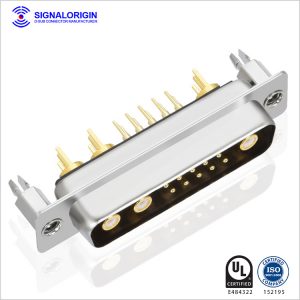 |
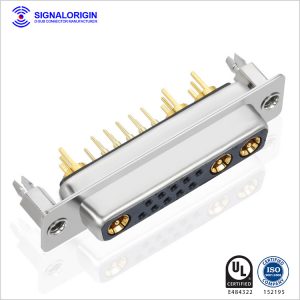 |
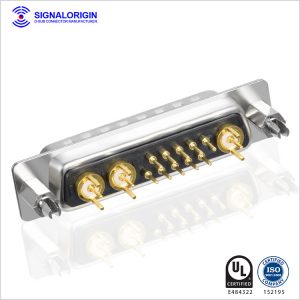 |
SIGNALORIGIN IP 67 connector
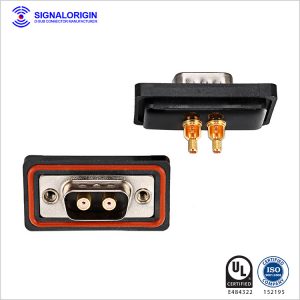 |
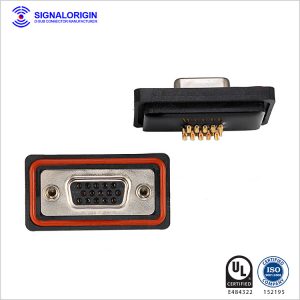 |
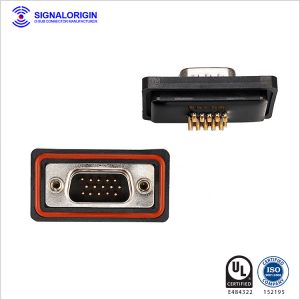 |
The widest application of D-subs is for RS-232 serial communications, though the standard did not make this connector mandatory. RS-232 devices originally used the DB25, but for many applications the less common signals were omitted, allowing a DE-9 to be used. The standard specifies a male connector for terminal equipment and a female connector for modems, but many variations exist.
Many uninterruptible power supply units have a DE-9F connector on them in order to signal to the attached computer via an RS-232 interface. Often these do not send data serially to the computer but instead use the handshaking control lines to indicate low battery, power failure, or other conditions. Such usage is not standardized between manufacturers and may require special cables.
The complete range of D-sub connectors also includes DA15s (one row of 7 and one of 8), DC37s (one row of 18 and one of 19), and DD50s (two rows of 17 and one of 16); these are often used in industrial products, the 15-way version being commonly used on rotary and linear encoders.
In broadcast and professional video, “parallel digital” is a digital video interface that uses DB25 connectors, per the SMPTE 274M specification adopted in the late 1990s. The more common SMPTE 259M “serial digital interface” (SDI) uses BNC connectors for digital video signal transfer.
D-SUB 37 connectors are commonly used in Hospital facilities as an interface between hospital beds and nurse call systems, allowing for the connection and signaling of Nurse Call, Bed Exit, and Cord out including TV entertainment and lighting controls.
Usage of D-sub connector
- The 25-pin D-sub connector is still occasionally used in recording studios for multi-channel analog audio and AES digital audio.
- The D-sub connector family is now out of general usage in the computer industry, due to size and cost. For portable devices such as PDAs, MP3 players, laptops, and smartphones, the D-sub connector is far too large to fit.
- Because of their relative complexity (the D-shaped metal shield, the screws and nuts), D-sub connectors are inherently more expensive than later connectors that superseded them.
- The physical design of D-sub connectors is ill-suited for consumer plug-and-play applications. Thin metal pins, especially in higher-density connectors, are easily bent or broken, particularly if frequently plugged in by touch behind equipment. The need to tighten screws for a secure connection is cumbersome. There is a high risk of shorting the male pins with the mating connector’s surrounding lip as well. Although ESD- and EMI-resistant D-sub connectors exist, the fundamental design was never intended to protect from electrostatic discharge or electromagnetic interference or facilitate very high frequency interconnections.
You may also like What businesses does SIGNALORIGIN engage in?
If you’re interested in purchasing high-quality, durable connectors, be sure to check out the wide range of standard and custom products from SIGNALORIGIN.
Contact us
 |

